
Nefertari, also known as Nefertari Meritmut, was an Egyptian queen and the first of the Great Royal Wives of Ramesses the Great. Nefertari means 'beautiful companion' and Meritmut means 'Beloved of the goddess Mut'. She is one of the best known Egyptian queens, among such women as Cleopatra, Nefertiti, and Hatshepsut, and one of the most prominent not known or thought to have reigned in her own right. She was highly educated and able to both read and write hieroglyphs, a very rare skill at the time. She used these skills in her diplomatic work, corresponding with other prominent royals of the time. Her lavishly decorated tomb, QV66, is one of the largest and most spectacular in the Valley of the Queens. Ramesses also constructed a temple for her at Abu Simbel next to his colossal monument there.
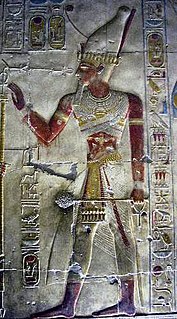
Menmaatre Seti I was the second pharaoh of the Nineteenth Dynasty of Egypt during the New Kingdom period, ruling c.1294 or 1290 BC to 1279 BC. He was the son of Ramesses I and Sitre, and the father of Ramesses II.

The New Kingdom, also referred to as the Egyptian Empire, is the period in ancient Egyptian history between the sixteenth century BC and the eleventh century BC, covering the Eighteenth, Nineteenth, and Twentieth dynasties of Egypt. Radiocarbon dating places the exact beginning of the New Kingdom between 1570 BC and 1544 BC. The New Kingdom followed the Second Intermediate Period and was succeeded by the Third Intermediate Period. It was Egypt's most prosperous time and marked the peak of its power.

Merneptah or Merenptah was the fourth pharaoh of the Nineteenth Dynasty of Ancient Egypt. He ruled Egypt for almost ten years, from late July or early August 1213 BC until his death on May 2, 1203 BC, according to contemporary historical records. He was the thirteenth son of Ramesses II, only coming to power because all his older brothers had died, including his full brother Khaemwaset or Khaemwase. By the time he ascended to the throne, he was probably around seventy years old. He is perhaps best known for his victory stele, featuring the first known mention of the name Israel. His throne name was Ba-en-re Mery-netjeru, which means "The Soul of Ra, Beloved of the Gods".

Amenmesse was the fifth pharaoh of the Nineteenth Dynasty in Ancient Egypt, possibly the son of Merneptah and Queen Takhat. Others consider him to be one of the innumerable sons of Ramesses II. Very little is known about this pharaoh, who ruled Egypt for only three to four years. Various Egyptologists date his reign between 1202 BC–1199 BC or 1203 BC–1200 BC with others giving an accession date of 1200 BC. Amenmesse means "born of or fashioned by Amun" in Egyptian. Additionally, his nomen can be found with the epithet Heqa-waset, which means "Ruler of Thebes". His royal name was Menmire Setepenre.

Bintanath was the firstborn daughter and later Great Royal Wife of the Egyptian Pharaoh Ramesses II.

Maathorneferure was an ancient Egyptian queen, the Great Royal Wife of Ramesses II.

Isetnofret was one of the Great Royal Wives of Pharaoh Ramesses II and was the mother of his heir, Merneptah. She was one of the most prominent of the royal wives, along with Nefertari, and was the chief queen after Nefertari's death.
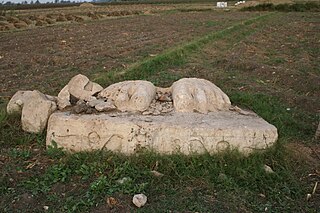
Pi-Ramesses was the new capital built by the Nineteenth Dynasty Pharaoh Ramesses II at Qantir, near the old site of Avaris. The city had served as a summer palace under Seti I, and may have been founded by Ramesses I while he served under Horemheb.
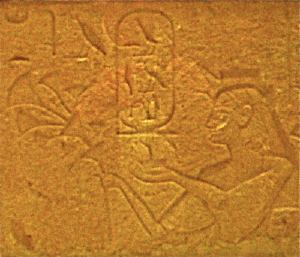
Tuya was the wife of Pharaoh Seti I of the Nineteenth Dynasty of Egypt and mother of Tia, Ramesses II, and perhaps Henutmire.

The Libu were an Ancient Libyan tribe of Berber origin, from which the name Libya derives.

Ramesses was an ancient Egyptian crown prince during the 19th Dynasty.
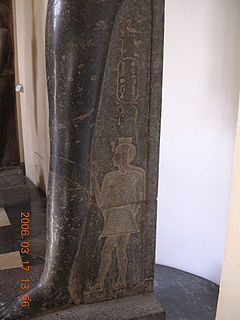
Henutmire was an ancient Egyptian princess and queen. She was one of the eight Great Royal Wives of Pharaoh Ramesses II of the 19th Dynasty of Egypt.

Nebettawy(nb.t-t3.wỉ; “Lady of the Two Lands”) was an ancient Egyptian princess and queen, the fifth daughter and one of the eight Great Royal Wives of Pharaoh Ramesses II.

Meryatum was an ancient Egyptian prince and High Priest of Re, the son of Pharaoh Ramesses II and Nefertari.
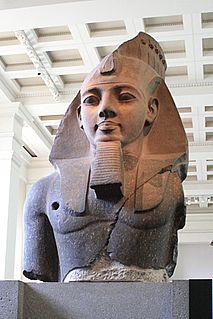
Ramesses II was the third pharaoh of the Nineteenth Dynasty of Egypt. He is often regarded as the greatest, most celebrated, and most powerful pharaoh of the New Kingdom, itself the most powerful period of Ancient Egypt.
The Bible makes reference to various pharaohs of Egypt. These include unnamed pharaohs in events described in the Torah, as well as several later named pharaohs, some of whom were historical or can be identified with historical pharaohs.

The Merneptah Stele, also known as the Israel Stele or the Victory Stele of Merneptah, is an inscription by Merneptah, a pharaoh in ancient Egypt who reigned from 1213–1203 BCE. Discovered by Flinders Petrie at Thebes in 1896, it is now housed at the Egyptian Museum in Cairo.
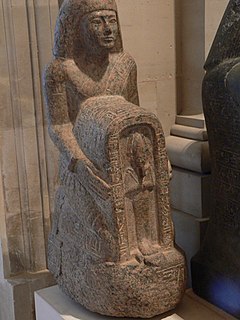
Yuyu was an ancient Egyptian High Priest of Osiris at Abydos, during the reign of pharaohs Ramesses II and possibly Merenptah of the 19th Dynasty.
Mery was an ancient Egyptian High Priest of Osiris at Abydos, during the reign of pharaoh Sety I and Ramesses II of the 19th Dynasty.


















